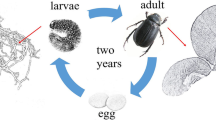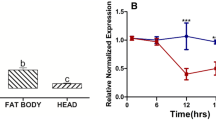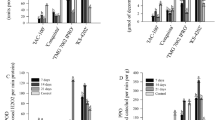Abstract
Bt soybean cultivation is increasing worldwide. The Cry1Ac protein expressed in Bt soybean efficiently controls several lepidopteran pests. The stink bug, Piezodorus guildinii (Westwood), a major pest for soybean in the Americas, is not controlled by Bt crops, although possible sub-lethal effects may occur. Even if there were no negative effects for sting bug, ingesting toxins could affect its bio-controllers. We tested through ELISA detection if P. guildinii ingests Cry1Ac from Bt soybean and possible effects on its development, reproduction, survival, and feeding behavior. Biological traits were evaluated under controlled conditions of nymphs and adults feeding on pods of near-isogenic cultivars DM5958iPRO (Bt) and DM59i (non-Bt). Feeding behavior was recorded using an AC-DC electropenetrography (EPG) device. Results indicated that P. guildinii ingested the Cry1Ac protein; however, nymphal period and accumulated survival percentage did not differ between cultivars. Feeding on Bt soybean pods did not affect fecundity (i.e., number of egg masses and eggs/female) nor egg viability. Different feeding behaviors were only detected on the pathway phase (stylet penetration into plant tissue), which was more pronounced in the Bt cultivar. However, the total duration of the feeding activities on seeds was numerically higher (ca. 2X) on Bt plants compared to non-Bt. This is the first study to demonstrate that P. guildinii does ingest the Cry1Ac protein and excrete it without being absorbed, probably explaining the lack of direct adverse effects on its biological parameters. EPG could indicate that Bt soybean plants might be less palatable than non-Bt to red-banded stink bug.





Similar content being viewed by others
Data Availability
The data that support the findings of this study are available on demand.
References
Amutkan D, Suldudere Z, Candan S (2015) Ultrastructure of digestive canal of Graphosoma lineatum (Linnaeus, 1758) (Heteroptera: Pentatomidae). J Entomol Res Soc 17:75–96
Backus EA, Bennett WH (2009) The AC-DC Correlation Monitor: new EPG design with flexible input resistors to detect both R and emf components for any piercing-sucking hemipteran. J Insect Physiol 55:869–884
Baur ME, Sosa-Gomez DR, Ottea J, Leonard BR, Corso IC, Da Silva JJ, Temple J, Boethel DJ (2010) Susceptibility to insecticides used for control of Piezodorus guildinii (Heteroptera: Pentatomidae) in the United States and Brazil. J Econ Entomol 103:869–876
Bayer (2022) Crop Science R&D Pipeline Update Webinar February 2022. https://www.bayer.com/en/investors/crop-science-rd-pipeline-update-webinar-2022-02. Accessed 9 Aug 2022
Bell HA, Down RE, Fitches EC, Edwards JP, Gatehouse AMR (2003) Impact of genetically modified potato expressing plant-derived insect resistance genes on the predatory bug Podisus maculiventris (Heteroptera: Pentatomidae). Biocontrol Sci Technol 13:729–741
Bell HA, Down RE, Edwards JP, Gatehouse JA, Gatehouse AMR (2005) Digestive proteolytic activity in the gut and salivary glands of the predatory bug Podisus maculiventris (Heteroptera: Pentatomidae); effect of proteinase inhibitors. Eur J Entomol 102:139–145
Bortolotto OC, Pomari-Fernandes A, Bueno RDF, Bueno ADF, da Kruz YKS, Queiroz AP, Sanzovo A, Ferreira RB (2015) The use of soybean integrated pest management in Brazil: a review. Agron Sci Biotechnol 1:25–32
Brandt SL, Coudron TA, Habibi J, Brown GR, Ilagan OM, Wagner RM, Wright MK, Backus EA, Huesing JE (2004) Interaction of two Bacillus thuringiensis δ-endotoxins with the digestive system of Lygus hesperus. Curr Microbiol 48:1–9
Bueno AD, Panizzi AR, Hunt TE, Dourado PM, Pitta RM, Gonçalves J (2021) Challenges for adoption of integrated pest management (IPM): the soybean example. Neotrop Entomol 50:5–20
Cervantes FA, Backus AE, Godfrey L, Rojas MG, Akbar W, Clark TL (2019) Quantitative differences in feeding behavior of Lygus lineolaris (Hemiptera: Miridae) on transgenic and nontransgenic cotton. J Econ Entomol 112:1920–1925
Corrêa-Ferreira BS, de Azevedo J (2002) Soybean seed damage by different species of stink bugs. Agric for Entomol 4:145–150
da Cunha FM, Caetano FH, Wanderley-Teixeira V, Torres JB, Teixeira AAC, Alves LC (2012) Ultra-structure and histochemistry of digestive cells of Podisus nigrispinus (Hemiptera: Pentatomidae) fed with prey reared on Bt-cotton. Micron 43:245–250
EnviroLogix (2013) QuickStik kit for quickscan cry1a(c) soy bulk soybean. Portland, USA, 11p.https://www.envirologix.com/wp-content/uploads/2018/04/AS075-STC-WS3-Cry1-1F-CP4-V3-021914.pdf. Accessed 20 Nov 2022
Fehr WR, Caviness CE (1977) Stages of soybean development. Iowa State University Special Report 87:929–931
Food and Agriculture Organization of the United Nations - FAOSTAT (2019) Production crops 2019.https://www.fao.org/faostat/en/#data/QCL. Accessed 20 Nov 2022
Jesus FGD, Junior ALB, Alves GC, Zanuncio JC (2014) Behavior, development, and predation of Podisus nigrispinus (Hemiptera: Pentatomidae) on Spodoptera frugiperda (Lepidoptera: Noctuidae) fed transgenic and conventional cotton cultivars. Ann Entomol Soc 107(3):601–606
Justiniano W, Fernandes MG, Viana CLTP (2014) Diversity, composition and population dynamics of arthropods in the genetically modified soybeans Roundup Ready® RR1 (GT 40-3-2) and Intacta RR2 PRO® (MON87701 x MON89788). J Agric Sci 6:33
Lucini T, Panizzi AR, Backus EA (2016) Characterization of an EPG waveform library for redbanded stink bug, Piezodorus guildinii (Hemiptera: Pentatomidae), on soybean plants. Ann Entomol Soc Am 109:198–210
Olson DM, Ruberson JR, Zeilinger AR, Andow DA (2011) Colonization preference of Euschistus servus and Nezara viridula in transgenic cotton varieties, peanut, and soybean. Entomol Exp Appl 139:161–169
Panizzi AR, McPherson JE, James DG, Javahery M, McPherson RM (2000) Stink bugs (Pentatomidade). In: Schaefer CW, Panizzi AR (eds) Heteroptera of Economic Importance, 1st edn. CRC Press, Florida, pp 421–474
Panizzi AR, Lucini T, Aldrich JR (2022) Dynamics in pest status of phytophagous stink bugs in the Neotropics. Neotrop Entomol 51:18–31
Pons X, Lumbierres B, López C, Albajes R (2005) Abundance of nontarget pests in transgenic Bt-maize: a farm scale study. Eur J Entomol 102:73–79
Raps A, Kehr J, Gugerli P, Moar WJ, Bigler F, Hilbeck A (2001) Immunological analysis of phloem sap of Bacillus thuringiensis corn and of the nontarget herbivore Rhopalosiphum padi (Homoptera: Aphididae) for the presence of Cry1Ab. Mol Ecol 10:525–533
Romeis J, Dutton A, Bigler F (2004) Bacillus thuringiensis toxin (Cry1Ab) has no direct effect on larvae of the green lacewing Chrysoperla carnea (Stephens) (Neuroptera: Chrysopidae). J Insect Physiol 50:175–183
Schünemann R, Roggia S, Muraro DS, Knaak N, Fiuza LM (2018) Insecticidal potential of Bacillus thuringiensis for the biological control of neotropical brown stink bug. Entomol Exp Appl 166:131–138
Silva GV, Pasini A, Bueno ADF, Bortolotto OC, Barbosa GC, Cruz YKS (2014) No impact of Bt soybean that express Cry1Ac protein on biological traits of Euschistus heros (Hemiptera, Pentatomidae) and its egg parasitoid Telenomus podisi (Hymenoptera, Platygastridae). Rev Bras Entomol 58:285–290
Sun J, Mooney H, Wu W, Tang H, Tong Y, Xu Z, Huang B, Cheng Y, Yang X, Wei D, Zhang F (2018) Importing food damages domestic environment: Evidence from global soybean trade. Proc Natl Acad Sci USA 115:5415–5419
Temple JH (2011) Redbanded stink bug, Piezodorus guildinii (Westwood): pest status, control strategies, and management in Louisiana soybean. Doctoral Dissertation, Baton Rouge, Louisiana State University, USA
Torres JB, Ruberson JR (2008) Interactions of Bacillus thuringiensis Cry1Ac toxin in genetically engineered cotton with predatory heteropterans. Transgenic Res 17:345–354
Torres JB, Ruberson JR, Adang MJ (2006) Expression of Bacillus thuringiensis Cry1Ac protein in cotton plants, acquisition by pests and predators: a tritrophic analysis. Agric Entomol 8:191–202
Torres JB, Barros EM, Coelho RR, Pimentel RM (2010) Zoophytophagous pentatomids feeding on plants and implications for biological control. Arthropod Plant Interact 4:219–227
Wilson EB (1927) Probable inference, the law of succession, and statistical inference. J Am Stat Assoc 22:209–212
Yu H, Romeis J, Li Y, Li X, Wu K (2014) Acquisition of Cry1Ac protein by non-target arthropods in Bt soybean fields. PLoS ONE 9:1–8
Zerbino MS, Panizzi AR (2019) The underestimated role of pest pentatomid parasitoids in Southern South America. Arthropod-Plant Interact 13:703–718
Zerbino MS, Altier N, Panizzi AR (2016) Performance of nymph and adult of Piezodorus guildinii (Westwood) (Hemiptera: Pentatomidae) feeding on cultivated legumes. Neotrop Entomol 45:114–122
Acknowledgements
We thank “Dr. Mario A. Cassinoni” Experimental Station the Embrapa Unit at Passo Fundo, RS, for support.
Funding
This research was part of a scholarship from Agencia Nacional de Investigación e Innovación ANII-Uruguay (POS_NAC_2011_1_3559) and Comisión Académica de Posgrado CAP- Universidad de la República, Uruguay to SA.
Author information
Authors and Affiliations
Contributions
SA, XP, NA, ARP, and TL conceived and designed the research. SA, ARP, TL, SB, AAP, HS, GDS, and LI co-worked on published data. OB, HS, and SA analyzed the data. SA wrote the paper with the contributions of ARP, XP, NA, TL, and HS. All authors read and approved the manuscript.
Corresponding author
Ethics declarations
Conflict of interest
The authors declare no competing interests.
Additional information
Edited by Marcos R de Faria
Publisher's Note
Springer Nature remains neutral with regard to jurisdictional claims in published maps and institutional affiliations.
Rights and permissions
About this article
Cite this article
Abbate, S., Pons, X., Altier, N. et al. Bt Soybean Cry1Ac Does Not Affect Development, Reproduction, or Feeding Behavior of Red-Banded Stink Bug Piezodorus guildinii (Hemiptera: Pentatomidae). Neotrop Entomol 53, 415–423 (2024). https://doi.org/10.1007/s13744-024-01128-7
Received:
Accepted:
Published:
Issue Date:
DOI: https://doi.org/10.1007/s13744-024-01128-7




